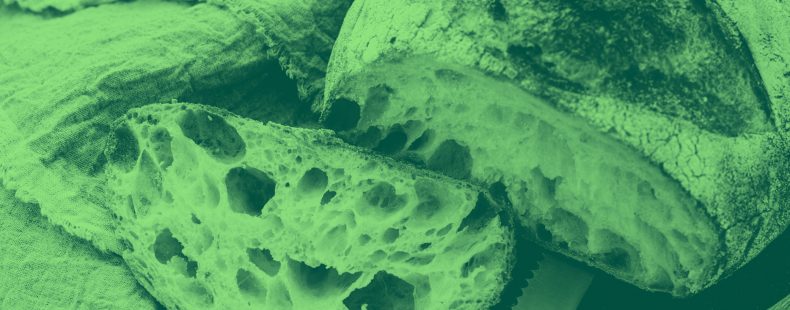Just about every culture in the world has a preferred regional bread style. And while the flavors, shapes, and exact ingredient lists may vary, there’s no denying that bread is near universally loved—especially when it’s homemade and fresh out of the oven. Home bakers may get a rise out of knowing that homemade loaves even have their own unofficial holiday: Homemade Bread Day on November 17.
Whether you’re an experienced home breadmaker or you just happen to be on a roll trying out new recipes, these are the bread terms and styles you knead to know. Let’s start with a few words that relate to the complicated process of making the bread itself, and then we’ll sink our teeth into specific types of tasty breads, from boule to chapati.
autolyze
To autolyze is to undergo autolysis, which is a noun that refers to the destruction of an organism’s tissues or cells by substances produced within the organism. In terms of bread making, it means to allow the bread to self digest.
This happens when the baker mixes flour and water and allows the combination to rest for up to an hour. The method was created by French scientist Raymond Calvel in 1974 and allows the flour to fully hydrate, the gluten to start bonding, and fermentation to slow. After the resting time, the other ingredients are added in and the dough is kneaded.
crumb
To the average person, crumbs are definitely something present when eating bread. But to anyone who makes bread (or just really appreciates it), the crumb has less to do with miniscule pieces that need to be swept up and more to do with the body of the bread itself.
The crumb is the soft inner portion of a bread, making it the opposite of the crust. A bread like your standard packaged loaf from the grocery store has a tight crumb, meaning there are very small and regular holes. An open crumb is when the air pockets are larger like you might find in a sourdough loaf or ciabatta.
preferment
A preferment has nothing to do with the bread we prefer (and we prefer plenty). The term actually refers to a prior ferment, or a pre-ferment. So a preferment is a mix of dough that’s made ahead of time (sometimes a matter of hours before, other times days before) so that it has time to ferment before being added to the main heap of dough. This allows yeast and bacteria to add more flavor, decreases the amount of yeast needed, and makes your final dough stronger with better hydration.
If this all sounds like sourdough, that’s for good reason. Sourdough is a type of preferment. Others include levain (more on that later), poolish (a liquidy preferment), biga (slightly less water than poolish), and pâte fermentée (a portion of the day’s dough that’s saved to be added to the following day’s dough).
gluten
Few types of proteins get the level of attention that gluten does. Gluten is a group of proteins found in cereal grains. The exact types of proteins depend on which grain. Wheat has glutenins and gliadins, while rye has secalins and barley has hordeins.
The word gluten was first recorded in 1590–1600 and is originally from the Latin word for glue, glūten. Regardless of which grains you’re talking about, gluten makes the dough stretchy and the bread soft and chewy. They’re responsible for part of what makes bread delicious, but also are one of the main reasons some people can’t eat bread, whether that’s because they’re sensitive to gluten or because they have celiac disease and can’t tolerate gluten.
lame
The perfect loaves of bread have slits on top. Maybe it’s a series of small diagonal slits, like on a baguette, or maybe it’s a simple slice down the middle. The fanciest have an intricate pattern cut into the top. All of these slices, called scores, are made on top of the dough before putting it in the oven. This allows the inside of the bread to expand evenly as the steam leaves through the cuts while the bread cooks.
Home bakers can use a razor or super sharp knife to make the cuts. Professionals, however, opt for a lame, pronounced [ lahm ], which means “blade” in French. The little piece of crust that gets slightly more toasty along the edge of the score is sometimes called another French word: la grigne, pronounced [ green-yeh ], which means “the grin.”
levain
Levain, pronounced [ luh-vayn ], is a type of preferment that’s made with flour and water days before the bread is made. The baker adds commercial yeast or allows wild yeast to do the work of fermenting the levain. It’s the same as a sourdough starter, and the two terms can be used interchangeably, as well as just starter. Keep in mind, however, that a levain doesn’t always add a notable sour note. Sometimes a levain is only used once; other times the starter is repeatedly fed to be used for multiple loaves, picking up flavors from natural yeast and bacteria in the air over time.
boule
Boule, pronounced [ bool ], is French for “ball.” When it comes to bread, a boule is simply a round loaf. Different patterns may be scored on top depending on the baker, and you can find both sourdough and commercial yeast boules. The shape makes for one of France’s most famous bread styles. In fact, the French word for bakers, boulanger, comes from the round boules, as does the word for bakery, boulangerie.
baguette
France’s most famous bread needs no introduction. A baguette is a recognizable symbol of France—especially when it’s being carried from a Paris boulangerie in a paper bag. Baguette originally comes from the Italian bacchetta (little stick), which comes from Latin. The long and narrow loaves are protected in France by the 1993 Décret Pain, which dictates that traditional baguettes must be made on the bakery’s premises using only wheat flour, water, salt, and yeast. And you know your bread is always fresh from a boulangerie, as the law also states no additives or preservatives are allowed, so loaves quickly go stale.
Besides delectable bread, we’ve gained a lot from French, including these loanwords.
ciabatta
Ciabatta is an Italian word that translates literally to “slipper.” The word is better recognized in the bread world as a slightly flat bread that has an open crumb with large air pockets. This well-known bread is a newcomer compared to other historic European baked goods. It was named and promoted by miller Arnaldo Cavallari during the 1980s as a response to the increase of French baguettes in Italy—although some people do claim a similar traditional bread existed previously.
soda bread
Whereas most breads need some time to let the yeasts do their work, soda bread rises much faster thanks to the ingredient right there in the name. Baking soda, or sodium bicarbonate, mixed with flour, milk, and cream of tartar makes for a reliably fluffy bread. The term soda bread was first recorded in 1850–55 in Ireland, and became common during the famine when there were yeast shortages.
challah
Challah, pronounced [ khah-luh ], is a Jewish bread that’s prepared especially for the Jewish Sabbath. The leavened bread is made with yeast and eggs, and it’s immediately recognizable thanks to the braided shape of each loaf. In the Torah, God asked Israelites to leave a portion of bread (called challah) after they enter the Holy Land.
chapati
This unleavened bread is as flat as a pancake. Chapati originally comes from India, and is typically made with a whole-wheat flour dough that’s hand-stretched and baked on a griddle. It’s a type of roti, a word derived from Sanskrit that simply means “bread.” Chapati in particular gets its name from the Hindi word for “slap” or “flat”: chapat.
brioche
Brioche [ bree-ohsh ] is a French sweet bread made with eggs, yeast, flour, sugar, and butter. The term comes from Middle French from the Norman dialect word brier, which means “to knead.” The name is appropriate: thanks to all of the fat in the recipe, it takes some heavy kneading to get brioche dough to the right consistency where the final loaf is airy with a tight crumb.
focaccia
Some breads need extras thrown on top after their baking, others are already flavored with the ingredients before being tossed in the oven. Focaccia falls into the latter camp. This large and flat Italian bread is massaged with olive oil, salt, and often herbs before being cooked. The result is a flavorful, short-in-stature bread that can be slathered with tomato sauce or more olive oil, or be eaten solo.
Take the bread quiz
If you’ve reviewed all these terms and are ready to prove yourself, then head over to our short quiz, definitely worth breaking bread over.














